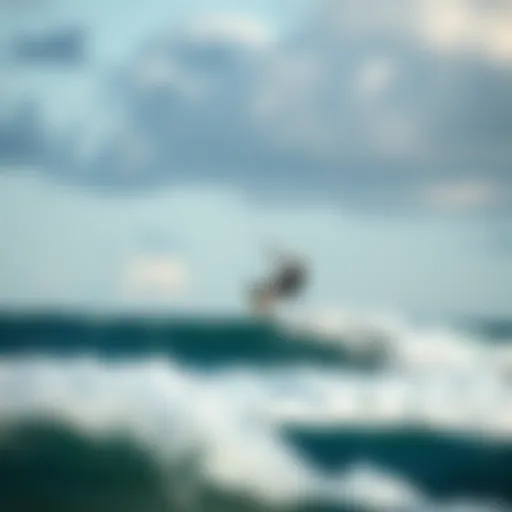Essential Insights on Buying Used Kitesurfing Gear


Intro
Kitesurfing has evolved into a thrilling sport that attracts adventure seekers worldwide. For many enthusiasts, buying used kitesurfing equipment can be a game changer, both financially and environmentally. However, navigating the second-hand market requires a good deal of knowledge. Whether you're a seasoned rider looking to upgrade or a beginner venturing into your first purchase, understanding what to look for in pre-owned gear is essential.
In this guide, we'll explore the market for used kitesurfing equipment, highlighting the advantages of choosing second-hand gear and the vital pointers for assessing quality. We also examine the evolving trends within the kitesurfing community, offering insights on sustainability while ensuring that you make informed choices for your kitesurfing adventures.
The focus here is on practical guidance—directly addressing kitesurfing instructors, coaches, and fellow riders. We aim to equip you with the knowledge you need to navigate this vibrant sector confidently, balancing cost-effectiveness with the need for reliable, quality equipment.
Understanding the Kitesurfing Equipment Market
The kitesurfing equipment market serves as a dynamic landscape where enthusiasts and professional riders converge to find their ideal gear. Understanding this market is crucial for anyone looking to dive into kitesurfing, whether you're a rookie or an experienced kiteboarder ready to upgrade.
Overview of Kitesurfing Equipment
Kitesurfing gear typically comprises several key components. A kite is the centerpiece, harnessing wind power to propel the rider across the water. Kites vary in size, shape, and construction, with some designed for beginners and others optimized for seasoned pros. The control bar and lines are essential for steering the kite, and a good quality one can significantly influence handling and performance.
The board is equally important. Boards come in various shapes and sizes, catering to different styles, like freestyle, wave riding, and racing. Size often depends on the rider's weight and skill level, with larger boards providing better stability for beginners.
Don’t forget about the harness—the lifeline connecting the rider to the kite. There are seat harnesses and waist harnesses, each offering different levels of comfort and control. Finally, safety gear like helmets and impact vests should never be overlooked. All these components work together harmoniously, making the right choice essential for an enjoyable kitesurfing experience.
Market Trends in Used Equipment
The past few years have showcased an increasing trend toward the purchase of used kitesurfing equipment. A few factors drive this growing interest. Firstly, there’s a significant cost advantage. New equipment can set a rider back substantially, and opting for used gear allows access to high-quality brands at a fraction of the price.
Another trend is driven by a shift towards sustainability. Many kitesurfers are becoming more conscious of their environmental impact. Purchasing second-hand gear helps reduce waste and supports a cycle of reuse. This is not just a trend; it’s quickly becoming a central principle for many water sports enthusiasts.
Additionally, online platforms have revolutionized how people buy and sell used kitesurfing gear. Websites and social media groups dedicated to kitesurfing make finding deals easier than ever. This connectivity means it’s possible to find specialized equipment that might not be available in local shops, expanding options for all riders.
"The market for used kitesurfing gear reflects a larger cultural shift towards sustainability and cost-effectiveness in outdoor sports."
As the market continues to evolve, keeping an eye on these trends is crucial for anyone looking to navigate the used kitesurfing equipment scene successfully.
Benefits of Buying Used Kitesurfing Gear
Buying used kitesurfing gear can be a smart choice, especially for those looking to engage with the sport without breaking the bank. There’s a myriad of benefits associated with opting for pre-owned equipment. Not only does it save money, but it also promotes a more sustainable approach to the sport and opens the door to high-quality brands at more affordable prices. Understanding these benefits can help potential kitesurfers make better decisions about their gear purchases.
Cost-Effectiveness
When it comes to kitesurfing, the costs can pile up quickly. A new kite, board, and accessories can set you back significantly. Buying used gear stands out as a practical solution that many enthusiasts embrace.
- Reduced Upfront Expenses: The most immediate benefit is the cost savings. Used equipment often comes at half or even a quarter of the price of new ones, which makes it easier to start your journey in kitesurfing.
- Quality for Less: Many seasoned kitesurfers invest in high-end gear that they frequently upgrade. As a result, you can find equipment from brands like North or Cabrinha that still has significant life left in it at a reasonable price.
- Less Risk: For beginners, investing in new gear can feel like a leap of faith, especially if you’re still figuring out if kitesurfing is for you. Buying used allows new starters to test the waters without a hefty financial commitment.
Environmental Considerations
Kitesurfing isn’t just about the thrill of the sport; it’s also about being conscious of our environment. In this regard, purchasing used gear carries notable ecological benefits.
- Sustainable choices: When you buy pre-owned equipment, you’re contributing to a circular economy, reducing the demand for new products and the resources that go into making them. Each kite or board that gets a second life lessens the environmental footprint of the sport.
- Waste Reduction: The kitesurfing industry produces a large volume of waste. Opting for used gear helps mitigate this issue, as it keeps items out of landfills and can extend the usable life of materials.
"Every piece of gear you use instead of letting it sit in a landfill is a victory for the planet."
Access to High-Quality Brands
A significant allure of the second-hand market is that it offers access to top-tier brands without the top-tier price tag.
- Brand Recognition: When looking into used gear, you might find well-known brands like Slingshot or Liquid Force at a fraction of their original price. It's an opportunity to ride some of the best equipment available without breaking the bank.
- Special Edition Gear: Sometimes one might stumble upon limited runs or special editions that no longer exist in retail, allowing enthusiasts to own unique pieces of equipment that stand out.
- Enhanced Knowledge: Buying used gear can lead to interactions with seasoned users, fostering connections within the community. Many sellers are passionate about their equipment and often share insights on how to best use and maintain the gear.
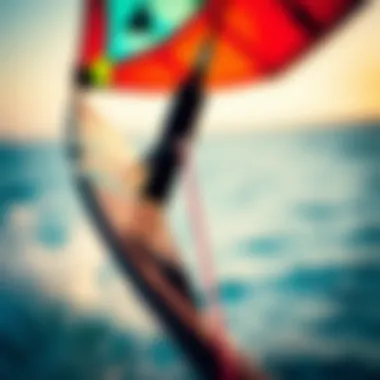

In summary, buying used kitesurfing gear is not just about saving a few bucks; it's a means of embracing the sport in a more ethical, sustainable way, while gaining access to high-quality brands that might otherwise be out of reach. Whether you're a seasoned pro or a newcomer trying to find your footing in the sport, considering the advantages of second-hand purchases can help you make informed choices.
Assessing the Quality of Used Equipment
When it comes to purchasing used kitesurfing gear, quality is non-negotiable. Unlike new equipment that carries the assurance of pristine condition, used gear can come with a range of issues—some visible, others not so much. Buyers need to be savvy to ensure they’re not left high and dry on the water due to faulty equipment. Assessing quality serves multiple purposes: it safeguards your investment, enhances your safety while kitesurfing, and helps you maintain performance standards. Moreover, knowing how to evaluate gear can also empower you to make more informed purchasing decisions.
Visual Inspection Techniques
A proper visual inspection is your first line of defense against subpar equipment. Start by checking the kite material for signs of wear. Look for fraying seams or any rips that could compromise integrity on the water. It's also worth inspecting the valves; they should be intact and free from cracks to ensure airtight sealing. Check the struts for any visible dents as well.
Equally, assess the board for damage. Scratches can be a dime a dozen but pay attention to the bottom. Delaminations can indicate deeper structural issues that a casual glance might miss. Inspect foot straps and fins as well for any signs of fatigue or excessive wear. Take your time; a thorough visual inspection can save you trouble down the line.
"Don't judge a book by its cover, but do check for dog-eared pages."
Understanding Gear Lifespan
Every piece of kitesurfing equipment has a specific lifespan, which can vary based on several factors including usage, maintenance, and storage conditions. Generally, kites can last anywhere from 2 to 5 years, while boards may have a lifespan slightly longer, often extending upwards of 5 years with proper care. The age of the gear often correlates with its performance and reliability.
When considering used equipment, finding out how frequently and under what conditions it was used can offer insights into its remaining life. For example, gear routinely stored in a garage versus gear left out in the sun year-round or subjected to saltwater could significantly affect their longevity.
Key Components to Evaluate
Delving deeper into the core of the equipment, certain components require extra scrutiny. For kites, be sure to look closely at the bridle system, as any fraying lines can indicate potential failures during use. Additionally, the condition of the pump is often overlooked: make sure it functions properly and that the hoses are not cracked.
For boards, check the fin boxes and foot strap inserts - these should be firmly in place with no signs of cracking or separation. The weight of the board can be a telling sign as well; a surprisingly light board might indicate damage or delamination.
In summary, understanding how to assess used kitesurfing equipment entails not just a look, but a methodical approach, diving into the details to ensure quality gear. Skim the surface and you might end up with second-rate gear that could hinder your performance in the water.
Navigating Online Marketplaces
In the digital age, acquiring used kitesurfing gear has never been easier. Online marketplaces have made it possible for enthusiasts at any level to find pre-owned equipment with just a few clicks. However, diving into these virtual waters can be tricky. Understanding how to navigate these platforms wisely is crucial, whether you're looking to snag a decent deal or offload your used gear. The importance of mastering this terrain is twofold: it allows buyers to save money while ensuring quality and gives sellers the platform they need to reach a broader audience.
Popular Platforms for Buying Used Gear
Many platforms exist where one can explore a plethora of options for kitesurfing gear. Here’s a rundown of some of the most popular places:
- eBay: This auction-style site hosts a treasure trove of kitesurfing gear. You may find everything from kites to boards here, often at competitive prices.
- Facebook Marketplace: A convenient choice for localized purchases. Sellers list items in their area, and it’s easy to arrange meetups or try the gear before buying.
- Craigslist: This classifieds site can yield great finds but requires diligence. Ensure you scrutinize listings and meet in safe, public locations.
- Specialized Gear Forums (e.g., KiteForum.com, Reddit's r/Kitesurfing): Community-driven platforms are goldmines for both buying and selling gear. Often, you'll find listings from fellow kitesurfers eager to upgrade or part with their gear.
- Local Kite Shops with an Online Presence: Some shops have dedicated sections for second-hand gear, ensuring the equipment has been inspected for safety and usability before sale.
Each platform has its nuances but knowing where to look can significantly streamline your kitesurfing gear search.
Tips for Safe Transactions
Diving into online transactions requires finesse. To avoid common pitfalls, keep these tips in mind:
- Research Before Purchase: Look up product specifications and average prices. This knowledge arms you when negotiating with sellers.
- Check Seller Ratings and Reviews: Platforms like eBay allow buyers to leave reviews. A seller with positive feedback is generally a safer bet.
- Communicate Clearly: Don't shy away from asking questions about the gear. Clarify details regarding wear, tear, and items’ history.
- Meet in Safe Public Locations: For local purchases via platforms like Facebook Marketplace or Craigslist, always meet at a busy, public place. It’s better to be safe than sorry.
- Avoid Upfront Payments: If possible, check the gear in person before finalizing any payment. Trust your instincts; if something feels off, walk away.
By adhering to these guidelines, you can ensure a smoother, safer transaction process.
"Making informed choices requires more than just enthusiasm—it demands caution and diligence to navigate these online waters effectively."
In the world of second-hand kitesurfing equipment, online marketplaces are vibrant, enabling connections and transactions that might have seemed daunting a few decades ago. With a bit of savvy and patience, you can sail smoothly toward the right kitesurfing gear for your next adventure.
Local Options for Purchasing Used Equipment
Exploring local options for purchasing used kitesurfing equipment can significantly enhance one’s experience as a kitesurfer. While online marketplaces offer convenience, local venues provide unique benefits that can enrich the buying journey. From establishing connections within the kitesurfing community to getting hands-on experience, locality brings a certain charm that online shopping just can't replicate.
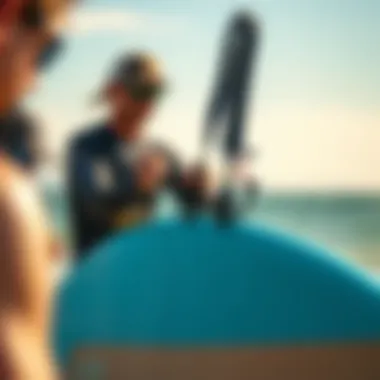
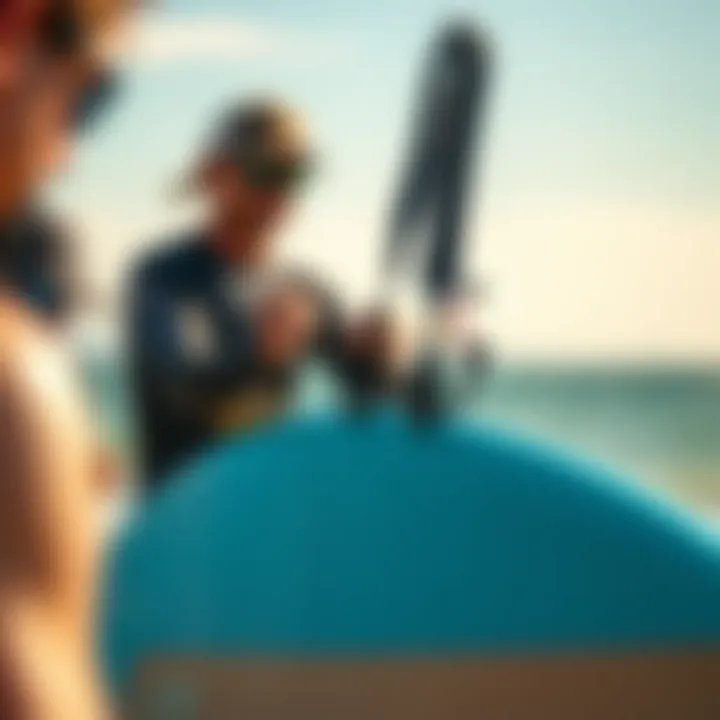
Kitesurfing Shops and Exchanges
Local kitesurfing shops are more than just retail spaces; they are hubs of community interaction and enthusiasm for the sport. Often, these shops have a dedicated section for used equipment, providing kitesurfers with the opportunity to explore a range of gear from different brands and price points.
- Personal Interaction: When visiting a kitesurfing shop, you're likely to meet knowledgeable staff who can provide insights about the gear. Having someone to discuss your needs with can yield better choices and recommendations tailored to your skill level and preferences.
- Safety and Reliability: One large advantage of purchasing from a local shop is the assurance of quality. Shops usually have a vetting process to ensure that the equipment meets safety standards and is free from any major defects. This minimizes the risk associated with buying secondhand gear.
- Opportunities for Exchange: Some shops also facilitate gear exchanges, where you can trade your old equipment for something different. This creates an excellent avenue for trying out new gear and ensuring that you keep up with the latest trends without spending a fortune.
Many shops also offer repair services for used gear, making it a one-stop-shop for kitesurfing enthusiasts. You might not just walk away with equipment but also relationships and resources that will serve you well on the water.
Community Events and Fairs
Community events and fairs tailored for water sports enthusiasts stand out as another invaluable local option for sourcing used kitesurfing equipment. These gatherings can take various forms, including competitions, festivals, or even social meetups. Here’s how engaging at these events can be beneficial:
- Networking Opportunities: Attending these events allows you to meet fellow kitesurfers, instructors, and clubs. Engaging with the local community can lead to information about where to find quality used gear, or even direct offers from individuals looking to sell their equipment.
- Hands-On Inspection: Often at events, enthusiasts are willing to bring their used gear for others to check out. This means you can examine the condition of a kite or board in-person, something that cannot be done through the screen of a computer. Seeing the equipment in person provides a clearer picture of its quality and usability.
- Competitive Prices: At fairs, you may encounter sellers motivated to offload their gear quickly. This can translate to significant savings for buyers. Plus, the absence of shipping fees is a bonus, as everything is right at your fingertips.
In summary, whether you’re strolling through a kitesurfing shop or mingling at community events, local purchasing options foster a sense of community while presenting opportunities to make informed and satisfying purchases. Your local radius might just hold the perfect kite or board waiting for you to pick it up.
Tips for Selling Used Kitesurfing Gear
Selling used kitesurfing gear can be quite a venture, not just for making a few bucks but also for passing on the enthusiasm of the sport to newcomers. In a niche market like kitesurfing, the way you handle your sale can significantly influence your overall success. Buyers are looking for quality products that make their investment worthwhile. Here are some effective tips to ensure a successful sale.
Preparing Gear for Sale
Before putting your gear on the market, it’s crucial to give it a once-over. Preparing your equipment properly can make a huge difference in how quickly it sells and at what price. Here are some steps to consider:
- Inspection: Start with a thorough inspection. Look for any wear and tear, such as frayed lines or damaged kites. Repair what you can; this shows you care about the product and not just the sale.
- Cleaning: Nobody wants to buy a dirty kite with sand and salt stains. Give your gear a good clean, paying special attention to the seams and any nooks and crannies.
- Documentation: If you still have manuals or warranty papers, gather those. A well-documented history can enhance the perceived value.
- Photographs: Take high-quality photographs in natural light. Show all sides of the gear and any blemishes. This transparency builds trust with potential buyers.
By enhancing the physical appearance and documentation of your gear, you make a compelling case for its value in the minds of buyers.
Effective Marketing Strategies
Once your gear is sparkling and ready, how do you get the word out? Marketing is the bridge between your product and potential buyers. Here are some strategies that can work wonders:
- Utilize Online Platforms: Post on websites like eBay, Facebook Marketplace, or specialized kitesurfing forums. Each platform has its own audience; choose the right ones for your gear’s niche.
- Leverage Social Media: Don’t underestimate the power of social networks. Consider posting in community groups dedicated to kitesurfing. Engage with followers and ask them to share your listing.
- Create a Detailed Listing: When you write your ad, describe your gear in detail. Use keywords that potential buyers might search for, such as "high-performance kite" or "used surfboard for sale." Include size, brand, and any unique features.
Effective marketing doesn’t just make your gear visible; it can also entice buyers to act quickly.
Setting the Right Price
Price can make or break a sale. Setting it too high might scare off buyers, while pricing it too low can mean leaving money on the table. Here are strategies for determining that sweet spot:
- Research Market Rates: Look at similar items on the market to gauge current trends. Analyze how long they’ve been listed to determine how well they are moving.
- Consider the Condition: Adjust your price according to the equipment’s condition. Make sure to provide reasoning for your price based on wear, repairs made, and original value.
- Be Open to Negotiation: Understanding that many buyers will want to haggle is essential. Set your initial price at a point that leaves room for negotiation. This gives buyers a sense of agency in the transaction.
Using these pricing strategies allows you to remain competitive while ensuring you get fair value for your gear.
The success of your sale often hinges on how well you prepare, market, and price your gear. Attention to detail can lead to smoother transactions and satisfy buyers, helping the whole community thrive.
Legal and Safety Considerations
When venturing into the realm of used kitesurfing equipment, understanding the legal and safety considerations is paramount. The thrill of kitesurfing is undeniable, but it must come with a solid foundation in responsible practices that protect both the rider and the equipment. Diving into these details can help avoid unexpected pitfalls down the line.
Warranty and Return Policies
The first thing to ponder when purchasing second-hand gear is the warranty and return policies. Some sellers may still honor warranties from manufacturers, while others, particularly private sellers, might not offer any return option at all. Here’s a key way to navigate this:
- Ask for Documentation: When you're scoping out gear, don’t shy away from asking for the original purchase receipt. This can clarify whether any warranties are still active.
- Understand Seller Policies: Different sellers will have different policies. Retail resellers generally provide return options, while individual sellers may have a "sold as is" approach.
- Clarify Terms: Gain clarity on what returns may cover—like minor defects, or if they're only for major issues.
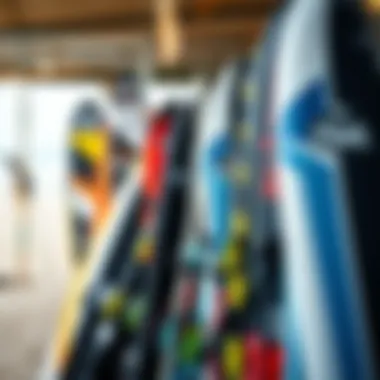
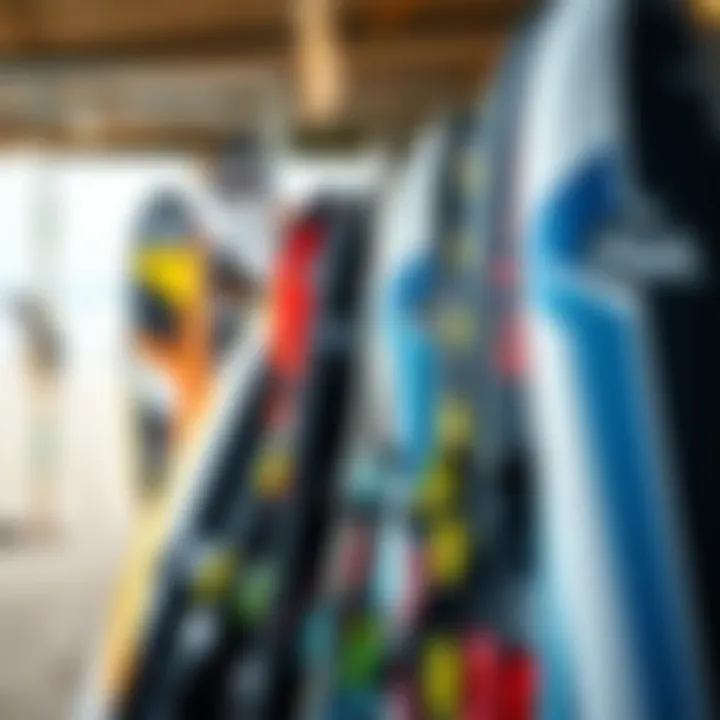
Remember: A clearer understanding equates to a safer purchase. You want to ensure you're not stuck with faulty equipment.
Safety Standards for Used Gear
Just as critical as warranties is understanding the safety standards for used gear. Improperly maintained or outdated equipment can lead to accidents. Here are some factors to consider:
- Inspect for Wear and Tear: Examine lines, kites, boards, and harnesses. Look for frays, tears, or cracks that could signal potential failure.
- Research Brand Reputation: Not all brands adhere to the same standards when it comes to safety. Engage in some research on the brand's history and customer feedback to gauge reliability.
- Check Industry Certifications: Look for industry certifications that guarantee a certain level of safety standards in manufacturing. Such certifications often indicate the item met rigorous checks before hitting the shelves.
- Ask About Previous Use: Inquire about how the previous owner used the gear. Heavy use in rough conditions can significantly impact its lifespan.
In short, prioritizing legal and safety considerations not only enhances your kitesurfing enjoyment but also ensures you engage responsibly with your equipment and fellow enthusiasts. Keep these points in mind, and you'll be better prepared to enjoy the thrill of the waves safely.
Sustainability in Kitesurfing Equipment
Embracing sustainability in the kitesurfing equipment sector is more than just a trend; it’s a crucial shift in how enthusiasts and newcomers alike approach their sport. As awareness about environmental issues grows, kitesurfers are increasingly looking to minimize their ecological footprint. The importance of sustainability is multi-faceted, focusing on reducing waste, conserving resources, and encouraging responsible manufacturing practices.
Impact of Second-Hand Market
The second-hand market for kitesurfing equipment plays a significant role in promoting sustainability. When pre-owned gear is circulated rather than discarded, it helps to curtail the demand for new products, which often involve extensive resource extraction and manufacturing. Each piece of used equipment that finds a new home is one less item contributing to landfill overflow.
Consider the following aspects:
- Reduction of Waste: The growing number of unused or barely used kites, boards, and harnesses makes the second-hand market ripe for those looking to save the environment.
- Lifecycle Benefits: Extending the lifecycle of existing gear by buying used can alleviate the demand for newer models, ultimately benefiting manufacturers willing to rethink their production practices.
- Lower Carbon Footprint: Shipping and production of new products often involve substantial carbon emissions. By purchasing used gear, kitesurfers make a conscientious choice to lower their environmental impact.
As kitesurfers embrace the second-hand market, they not only save money but also contribute to a more sustainable cycle of consumption.
Promoting Eco-Friendly Practices
To further enhance sustainability in kitesurfing, adopting eco-friendly practices within the sport is essential. Here are some strategies that can be implemented:
- Choosing Sustainable Brands: Opting for manufacturers who prioritize eco-friendly materials and production methods can help steer the market towards sustainability.
- Maintenance and Repair: Taking good care of equipment and prioritizing repairs can extend the life of gear, thus delaying the need for replacements.
- Local Upcycling Initiatives: Engaging in local programs that repurpose old kitesurfing equipment into new items, such as bags or accessories, adds another layer of environmental consciousness.
Culmination: Making Informed Choices in the Used Market
Navigating the world of used kitesurfing equipment can feel like diving headfirst into the ocean without a life jacket. It's an endeavor that's both rewarding and filled with a few potential pitfalls. The conclusion of this guide underscores the importance of making informed choices, especially in a market where the ocean of options can be vast. Whether you're a seasoned boarder looking to update your gear or a beginner eager to catch your first wave without breaking the bank, understanding what drives your decisions is crucial.
Informed choices hinge upon several factors, including quality assessment and market trends discussed throughout this article. Buyers should keep an eye on the equipment's condition and performance potential. Knowing the lifespan of various gear can prevent the disappointment that comes with a purchase that looks great but glides poorly. Additionally, always consider the sustainability aspect: choosing used gear reflects not just individual preference but also a commitment to eco-friendly practices in kitesurfing, making each ride a little greener.
Another element is awareness of the legalities and safety standards surrounding used equipment. Misunderstanding these considerations can result in accidents or financial losses. Warranties and return policies aren’t just red tape; they protect you against faulty purchases. Being knowledgeable elicits confidence, ensuring you know what to ask and who to approach in the second-hand kitesurfing marketplace.
A significant point rests in the balance of excitement and caution. Buying used gear can save serious cash, but impulse buys might cost more in the long run. Inform your instincts by reflecting on the comprehensive info provided here, which encourages you to weigh the pros and cons before pressing that 'buy' button.
Ultimately, making informed decisions requires the fusion of knowledge, market awareness, and a commitment to sustainability. As you venture into the second-hand equipment realm, keep these principles at the forefront of your mind to not only enhance your performance but also your experience in kitesurfing.
Summarizing Key Points
To wrap things up neatly, remember these essential aspects of buying used kitesurfing gear:
- Cost savings are significant. You can find high-quality gear without emptying your wallet.
- Environmental impact is diminished by choosing second-hand equipment, contributing to sustainability efforts.
- Always conduct a visual inspection to assess quality, looking closely at the kites and boards for any wear or tear.
- Understand the lifespan and performance indicators of gear. Different brands have varying durability, affecting your long-term satisfaction.
- Familiarize yourself with safety standards and legalities related to buying used equipment to avoid mishaps.
By keeping these points in your back pocket, you can venture confidently into your kitesurfing journey, knowing you've equipped yourself with the right knowledge.
Encouraging Responsible Purchases
Encouraging responsible purchasing habits is not just about protecting your wallet; it's about shaping the future of kitesurfing. When you take time to select wisely, you contribute positively to the community and environment.
Engage with local kitesurfing shops or online marketplaces that prioritize transparency in their sales practices. Look out for stores that offer warranties or allow returns on their used gear. This practice not only benefits you, but it sends a message to retailers about the importance of customer satisfaction.
Share your experiences with other kitesurfers online. Engage in communities on Reddit or Facebook, where discussions are rich with advice and shared journeys.
Ultimately, the responsibility doesn't only lie on sellers; as a buyer, your choices shape the market. Think of your purchase as a vote for sustainability and quality in kitesurfing. Prioritize gear that not only fits your needs but also aligns with ethical and responsible practices. It’s not just kitesurfing; it’s being a steward of the sport.
As you stand on the beach ready to launch, remember: every informed choice you’ve made can lead to a glorious ride in the waves.









